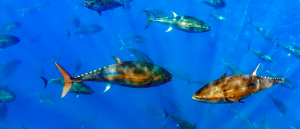How does baiting affect tiger sharks’ social behaviors?

Tiger sharks, always thought to be solitary creatures, might be more sociable than we think and even have preferences for other tiger sharks they spend time with.
In a 3-year study conducted by the University of Miami Rosenstiel School of Marine and Atmospheric Science (FL, USA) and the Institute of Zoology at the Zoological Society London (ZSL; UK) scientists tracked tiger sharks and collected data on their group and general social behavior.
The study, which took place at Tiger Beach – on the north–west side of Little Bahama in the Bahamas – also investigated the impact of shark baiting for tourist dives on the sharks’ social behavior. This area benefits from tourism from shark-diving encounters, whereby sharks are drawn to the area by chum (fish bait put into the water) and often fed in front of tourists too.
To interpret the tracking data collected from the sharks, the team used a tool called Social Network Analysis. They examined the social interactions of the sharks in a group setting, and whether these patterns in behavior changed depending on exposure to baiting and tourist attractions. The results showed that tiger sharks in general are more social, forming larger social groups than expected; in areas where sharks convened for food from tour operators, sharks were more aggregated and interactions became more random, suggesting a breakdown in relationships and social organization at these sites.
“Given that tiger sharks spend months at a time out in the open ocean as solitary predators, it’s amazing to me that they show social preferences for one another when they are at the Tiger Beach area,” stated Neil Hammerschlag, from the University of Miami Rosenstiel School and senior author of the study. “For nearly two decades, I have spent countless hours diving at Tiger Beach, always wondering if these apex predators interacted socially. Now we know.”
Climate change, temperature and tuna
Most fish are cold blooded, but some are warm blooded and this has hoodwinked marine biologists for some time as to the evolutionary advantage of this, especially as it seems to only occur in a few species.
Baiting sharks for tourism dives is a contentious issue, especially for conservationists and shark experts. By feeding the sharks and encouraging them to gather together in larger groups and at sites where they wouldn’t normally, there are concerns that it could have negative long-term effects on the sharks’ natural foraging behaviors.
The study showed that the social preferences the sharks displayed were not upheld as much when they came together at these bait sites. However, this is only a temporary disruption as the sharks would return to their original social groups once away from the tourist dive sites.
“The boundary between wildlife and people is becoming increasingly thin, so as well as observing a new social behavior for the first time in what was once thought of as a solitary shark, we also measured the impacts of human activity on these predators’ interactions. They seem to show some resilience to the bait feeding,” added David Jacoby (from the ZSL and lead author of the study) hopefully.
Elucidating the social patterns and preferences of predators can give researchers and wildlife conservationists vital information on how they live and what motivates them in different social behaviors. This helps conservationists to better understand the role of sharks in the ecosystem and how best to protect them.






